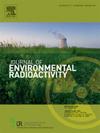Distinct food-web transfers of 137Cs to fish in river and lake ecosystems: A case study focusing on masu salmon in the Fukushima evacuation zone
IF 1.9
3区 环境科学与生态学
Q3 ENVIRONMENTAL SCIENCES
引用次数: 0
Abstract
This study was conducted to elucidate the spatial and size variations, and food-web transfer of 137Cs in freshwater fish in the upper reaches of the Ukedo River system, a highly contaminated river system flowing through the Fukushima evacuation zone. Fish collection and environmental surveys were conducted in the summer of 2020 at five forest rivers and at the Ogaki Dam reservoir (an artificial lake) with different air dose rates (mean 0.20–3.32 μSv/h). From the river sites, two salmonid species (masu salmon and white-spotted charr) were sampled, with masu salmon generally exhibiting higher 137Cs concentrations, ranging widely (10.6 Bq/kg-wet to 13.0 kBq/kg-wet) depending on the fish size (size effect) and site. The 137Cs concentrations in masu salmon were explained by the air dose rates, 137Cs concentrations in water, sediments (excluding the lake site), and primary producers, with site-specific variations. In the rivers, masu salmon (fluvial type with parr marks) mainly fed on terrestrial insects with higher 137Cs concentrations compared with those of aquatic insects, indicating that 137Cs was transferred mainly to fish through the allochthonous forest food-web during summer. In the lake, masu salmon (lake-run type with larger size and silvery body coloration) mainly preyed on smaller fish with lower 137Cs concentrations, demonstrating that 137Cs is transferred to fish through the autochthonous lake food-web with biomagnification. Differences in 137Cs concentrations among masu salmon (mean 441 Bq/kg-wet) and other fish species (mean 74.8 Bq/kg-wet to 2.35 kBq/kg-wet) were also found in the lake. The distinct 137Cs transfers to river and lake fish were supported by stable isotope analysis: δ15N and δ13C values enriched stepwisely through the food-webs were, respectively, higher and lower in the lake. Our results obtained using multiple approaches clearly revealed the distinct food-web transfer of 137Cs in river and lake ecosystems. These findings can contribute to prediction of radioactive contamination in freshwater fish in the Fukushima evacuation zone.
137Cs 在河流和湖泊生态系统中向鱼类的不同食物网转移:以福岛核泄漏区鲑鱼为重点的案例研究
本研究旨在阐明流经福岛疏散区的高污染河流--浮江户川水系上游淡水鱼体内 137Cs 的空间和大小变化以及食物网转移情况。2020 年夏季,在五条森林河流和大垣坝水库(人工湖)进行了鱼类采集和环境调查,空气剂量率各不相同(平均为 0.20-3.32 μSv/h)。在河流取样点,对两种鲑鱼(马苏鲑和白斑鲑)进行了取样,马苏鲑的 137Cs 浓度通常较高,根据鱼体大小(大小效应)和取样地点的不同,浓度范围较大(10.6 Bq/kg-wet 至 13.0 kBq/kg-wet)。沼泽鲑鱼体内的 137Cs 浓度可通过空气剂量率、水中 137Cs 浓度、沉积物(不包括湖泊地点)和初级生产者来解释,具体地点有所不同。在河流中,沼泽鲑(有稚鱼标记的河川型)主要摄食陆生昆虫,其 137Cs 浓度高于水生昆虫,这表明 137Cs 在夏季主要通过同源森林食物网转移到鱼类体内。在湖中,马苏鲑(体型较大、体色为银色的湖流型鲑鱼)主要捕食 137Cs 浓度较低的小型鱼类,这表明 137Cs 是通过自生的湖泊食物网转移到鱼类体内,并产生生物放大作用。湖中的马苏鲑(平均 441 Bq/kg-湿重)和其他鱼类(平均 74.8 Bq/kg-湿重至 2.35 kBq/kg-湿重)的 137Cs 浓度也存在差异。稳定同位素分析证实了 137Cs 向河流和湖泊鱼类的不同转移:通过食物网逐步富集的 δ15N 和 δ13C 值在湖泊中分别较高和较低。我们采用多种方法得出的结果清楚地揭示了 137Cs 在河流和湖泊生态系统中不同的食物网转移情况。这些发现有助于预测福岛核泄漏区淡水鱼体内的放射性污染。
本文章由计算机程序翻译,如有差异,请以英文原文为准。
求助全文
约1分钟内获得全文
求助全文
来源期刊

Journal of environmental radioactivity
环境科学-环境科学
CiteScore
4.70
自引率
13.00%
发文量
209
审稿时长
73 days
期刊介绍:
The Journal of Environmental Radioactivity provides a coherent international forum for publication of original research or review papers on any aspect of the occurrence of radioactivity in natural systems.
Relevant subject areas range from applications of environmental radionuclides as mechanistic or timescale tracers of natural processes to assessments of the radioecological or radiological effects of ambient radioactivity. Papers deal with naturally occurring nuclides or with those created and released by man through nuclear weapons manufacture and testing, energy production, fuel-cycle technology, etc. Reports on radioactivity in the oceans, sediments, rivers, lakes, groundwaters, soils, atmosphere and all divisions of the biosphere are welcomed, but these should not simply be of a monitoring nature unless the data are particularly innovative.
 求助内容:
求助内容: 应助结果提醒方式:
应助结果提醒方式:


